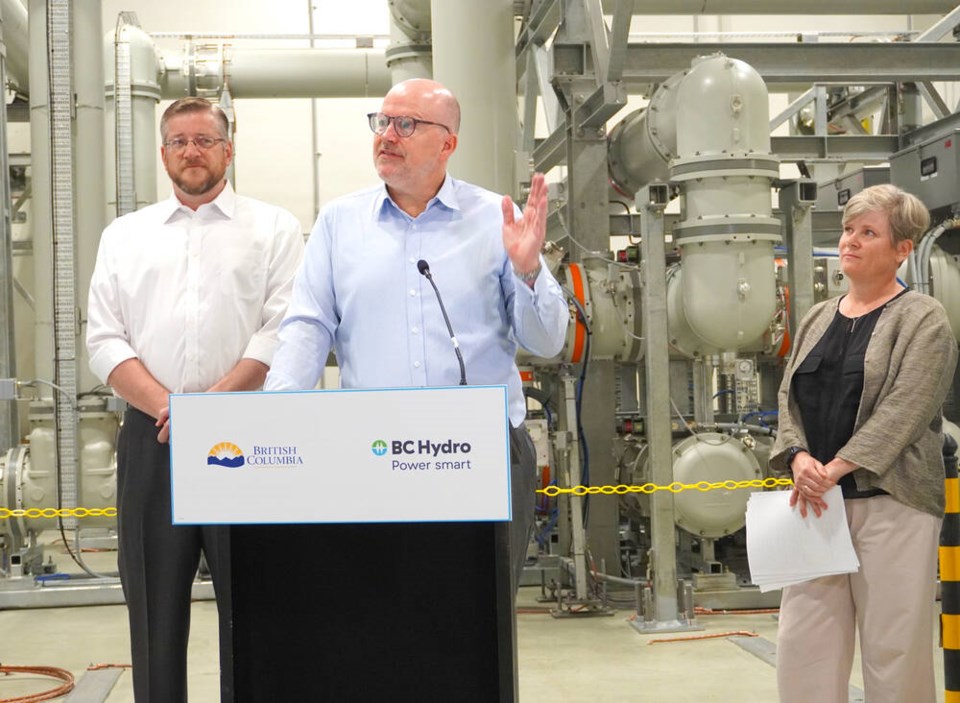BC Hydro is spending more than $500 million on infrastructure to keep the juice flowing and lights glowing as demand for electricity surges on the North Shore and Sea to Sky regions.
The public utility, along with Energy, Mines and Low Carbon Innovation Minister Josie Osborne, made the announcement Wednesday at the new, nearly complete Capilano Substation in North Vancouver.
Among the projects the cash is earmarked for: $300 million for seismic and reliability upgrades at the Cheakamus Dam between Squamish and Whistler, $120 million to replace and upgrade substations that are reaching the end of their service lives in Lynn Valley, Squamish and Pemberton, new transmission lines connecting the Maplewood industrial waterfront and Deep Cove to BC Hydro’s substation near the Second Narrows, voltage conversion upgrades serving Norgate and the British Properties, plus 10 kilometres of underground electrical infrastructure.
The announcement flows from BC Hydro’s $36-billion, 10-year capital plan, unveiled in January. The work is expected to require more than 10,000 skilled trades workers over the next decade.
Osborne acknowledged the need for more clean power in B.C. amid disastrous climate change.
“New housing starts are happening faster than we can believe. We’re attracting new businesses to our province and existing businesses are expanding their operations here. People are making the switch to electric vehicles. They’re installing heat pumps in record numbers,” she said. “So we need to make sure that we’re ready to meet the growing demand for clean power, and that we can get power where it’s needed, when it’s needed.”
Although not officially campaigning, the minister took the occasion to cast the surging BC Conservatives leader John Rustad as a denier of human-caused climate change and accused BC United’s leader Kevin Falcon of having no plan.
New power infrastructure can't come soon enough, says North Vancouver mayor
BC Hydro and the province have faced criticism that there won’t be enough capacity to supply and distribute even short-term energy needs, relying more on imported power that comes from carbon-intensive sources. BC Hydro is forecasting a 15-per-cent growth in demand for electricity by 2030, which executive vice-president of integrated planning Al Leonard said the public utility is striving to meet.
The Site C Dam is expected to come fully online in 2025, adding about eight per cent to B.C.’s total hydroelectric energy output. And the current open call for independent producers to supply another 3,000 gigawatt hours of electricity per year – about another five-per-cent beyond our existing capacity – is likely one of several such calls to come in the years ahead, he said.
Leonard said beyond producing and distributing more power, BC Hydro is expecting advances in technology and changes in consumer behaviour to help make more efficient use of the electricity already flowing through the grid.
When it comes online, the new Capilano Substation will be the first 20-kilovolt substation on the North Shore, with enough capacity to service another 10,000 to 17,500 homes. It will also be far more reliable and less susceptible to outages than the 1950s substation it is replacing. Leonard said it exemplifies the kind of infrastructure that BC Hydro will be building.
District of North Vancouver Mayor Mike Little, who was present for the announcement, said it was a step in the right direction. Little has previously expressed worries about the capacity of B.C.’s grid to service major industrial clients as well as residential ones that now include all electrical appliances and electric vehicle charging.
“The demand is going from what used to be about 60-amp service or 100-amp service, to multiple hundreds of amps of service for each individual house, and so the new applications we’re seeing are thirsty customers,” he said. “For the municipalities, this can’t come soon enough.”





